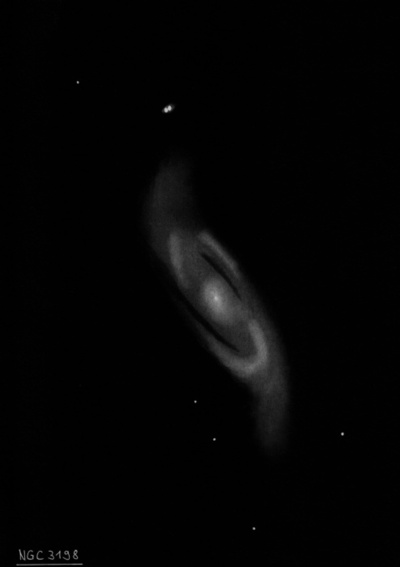
William Herschel discovered NGC 3198 = H I-199 = h695 on 15 Jan 1788 (sweep 800) and remarked "cB, mE, gbM, about 5' long and 2' broad from sp to nf." John Herschel wrote on 20 Mar 1828 (sweep 140), "F; vL; bM; mE; 6' large, 2.5' br; r[esolvable]." George Stoney, observing with LdR's 72" on 3 Mar 1850, noted "probably a faint spiral." It was included in the list of "Spiral or curvilinear" nebulae in LdR's 1850 PT paper. In later observations, a "dark vacuity ssp Nucl" was noted as well as "dark spaces throughout its length".
400/500mm - 17.5" (3/12/94): fairly bright, large, very elongated 3:1 SW-NE, 7.0'x2.5', broadly concentrated, brighter core has an indistinct elongated nucleus and an irregular surface brightness. Two mag 14 stars are close south (nearest is 2.0' from the center) and a mag 11 star is just off the NNE edge 3.5' from the center.
900/1200mm - 48" (5/4/16): at 375x; NGC 3198 is a showpiece, large spiral extending 7:2 SW-NE, ~8.0'x2.5'. Contains a bright, elongated central "bar", punctuated by a very small bright core that rises to a stellar nucleus. Slightly brighter patches are visible at the ends of the central region, where the spiral arms emerge. A tight inner arm is attached on the northeast end; it bends back sharply and closely parallels the central region, extending southwest for a length of ~3.5'. An outer low surface brightness arm sweeps clockwise on the southwest end. A symmetric outer arm on the northeast end (of slightly higher surface brightness) curls clockwise towards the west. The outer tip to tip diameter is nearly 8'. An uncatalogued fairly bright double star [separation ~3.7"] is 3.5' NNE of center, just beyond the halo and a mag 14 star is 2.2' SSE of center.
Notes by Steve Gottlieb